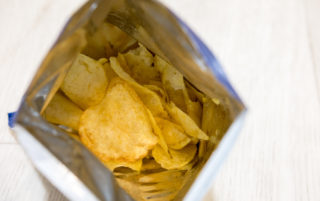 Have you ever taken a sip of your Grande Starbucks latte and thought to yourself with disgust, “I can’t believe that barista topped off my latte with milk foam!” Or polished off an eight-piece bucket of Kentucky Fried Chicken, and found yourself staring longingly into the bottom of the greasy container, wishing for more?
Have you ever taken a sip of your Grande Starbucks latte and thought to yourself with disgust, “I can’t believe that barista topped off my latte with milk foam!” Or polished off an eight-piece bucket of Kentucky Fried Chicken, and found yourself staring longingly into the bottom of the greasy container, wishing for more?
If your answer to these questions is no, then you are probably a “reasonable consumer,” according to recent court rulings in “slack-fill” class action lawsuits.
What is Slack-Fill?
Under the Federal Food, Drug, and Cosmetic Act (“FDCA”), “slack-fill” is defined as “the difference between the actual capacity of a container and the volume of product contained therein.” 21 C.F.R. § 100.100(a). In other words, slack-fill is the air in your bag of potato chips.
But Isn’t Slack-Fill Necessary?
As is often the case, the answer is: it depends. Slack-fill in product packaging is non-actionable when done for functional purposes, such as to protect the contents of the package or when due to unavoidable product settling during shipping and handling. 21 C.F.R. § 100.100(a) (1)-(6). However, any slack-fill in excess of the amount “necessary to accomplish a particular function” is considered “nonfunctional slack-fill.” Misleading Containers; Nonfunctional Slack-Fill, 58 Fed. Reg. 64123-01, 64126 (Dec. 6, 1993). While the FDA has not explicitly defined the term “in excess” as it relates to slack-fill, the guidelines suggest that the analysis is governed by a fact-specific reasonableness standard. For example, a gift item such as a large coffee mug which is only half-filled with candy may be deemed “functional” because part of that item’s function is to serve as a coffee container after the candy has been consumed. Id. An over-sized throwaway box of candy that is more than 80% empty, on the other hand, may contain an excess of actionable non-functional slack-fill.
What is the Legal Trend?
Judicial skepticism runs high in the area of slack-fill litigation. For example, in January 2018, a California judge found that “a reasonable consumer would not be misled into believing that foam does not count toward some portion of the volume of their [Starbucks] Latte.” Strumlauf v. Starbucks Corp., No. 16-CV-01306-YGR, 2018 WL 306715, at *6 (N.D. Cal. Jan. 5, 2018); see also Wurtzburger v. Kentucky Fried Chicken, No. 16-CV-08186 (NSR), 2017 WL 6416296, at *5 (S.D.N.Y. Dec. 13, 2017) (holding that Plaintiff’s Complaint, which “simply asserts that the bucket of chicken Plaintiff purchased could hold more chicken than the eight-pieces Plaintiff bargained for,” must be dismissed).
Nevertheless, slack-fill cases continue to be filed at a steady pace—accounting for about 11 percent of overall food and beverage class actions in 2017. The trend continues into 2018 with newly-filed complaints filed against popular snacks Junior Mints, Popcorners, and Werther’s Caramels. While many slack-fill cases are dismissed right out of the gate, “courts that have allowed slack-fill consumer protection cases to proceed beyond the motion to dismiss stage tend to do so because reasonableness was at issue and could not be resolved short of summary judgment or trial.” White v. Just Born, Inc., No. 2:17-CV-04025-C-NKL, 2017 WL 3130333, at *7 (W.D. Mo. July 21, 2017) (denying motion to dismiss in slack-fill case against Mike and Ike candy manufacturer because reasonableness was at issue).
What can companies do to protect themselves against slack-fill claims?
Recent decisions suggest that one of the easiest ways to guard against a slack-fill claim is to properly label a product with net weight or accurate serving sizes, especially if the packaging does not allow consumers to view the product itself prior to purchase. See Ebner v. Fresh, Inc., No. 13-56644, 2016 WL 5389307, at *6 (9th Cir. Sept. 27, 2016) (deception claim based on oversized packaging was implausible where net weight label was affixed to every tube); Hawkins v. UGI Corp., No. 14-08461, 2016 WL2595990 (C.D. Cal. May 4, 2016) (accurate net weight labels [ ] were not fraudulent, deceptive, or misleading); Bush v. Mondelez Int’l, Inc., No. 16-CV-02460-RS, 2016 WL 7324990, at *2 (N.D. Cal. Dec. 16, 2016) (Go-Pak product packaging not deceptive where labels disclose the net weight and number of cookies per container).
We will continue to provide updates on slack-fill litigation trends as 2018 progresses.
